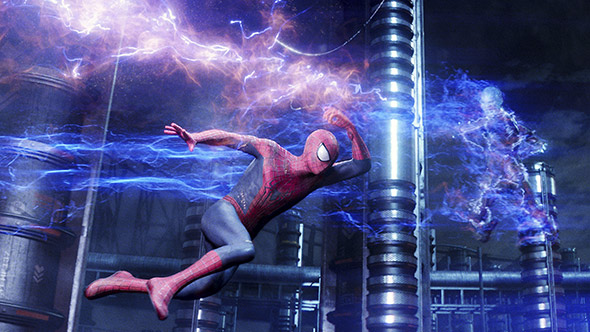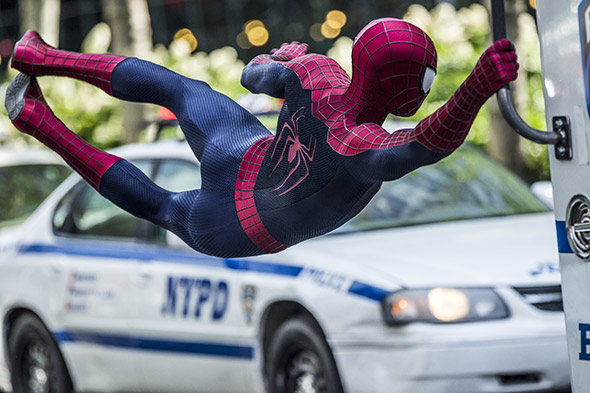Shooting 35mm, Mimicking Buster Keaton, and Building a Fake Times Square
Did you know The Amazing Spider-Man 2 was shot on film? Did you catch the stunt that the team borrowed from Buster Keaton? And what was up with that post-credits sequence, anyway? Reading the film's production notes and skimming countless filmmaker interviews from around the web, we've collected 10 tidbits of making-of information — from the film stocks that captured the action to the back-room deal that put the X-Men's Mystique on screen — that shed some light on the machinations behind Marvel's latest superhero offering. Every original source is footnoted and linked up at the bottom of this page, so scroll on down for more reading!
1. Film Gets a Sequel: The first
Amazing Spider-Man was shot in stereo 3D with the Red Epic recording 5K Redcode Raw.
The Amazing Spider-Man 2 was post-converted from 2D to 3D, in part because the production wanted to shoot 35mm film. DP Dan Mindel used Kodak Vision3 500T 5219 and 200T 5213, while the second unit shot day exteriors on Kodak Vision3 50D 5203. "Telling stories with motion pictures is really what interests me, and I like to use film as part of the emotional landscape of a story," Mindel said during the shoot, in an article published last year by Kodak.
[1]
2. If You Can Fake It There, You Can Fake It Anywhere: The film's major action scene set in Times Square was actually photographed at Long Island's Gold Coast Studios in Bethpage, NY, where a stretch of Broadway and Seventh Avenue between 46th and 47th streets was rebuilt. "We built a set that was literally the size of Times Square, with green screens literally as large as the screens that you see in Times Square, and we lit it up like Times Square," said co-producer Matthew Tolmach. The rest of the scene was recreated digitally in VFX.
[2]
3. Everyone Hold Your Breath: For the signature "Spider Sense" shot, in which time stands still for a moment as Spider-Man works out how to save a group of bystanders from Electro's attack, exceptionally athletic extras had to hold stock-still as the camera ran. "[Stunt coordinator] Andy Armstrong found dancers, athletes, people with very good muscle control, and we had them hold still, as best they could, for the five or six minutes it took to get the camera through. Everyone practiced for weeks, holding a pose, whether they were standing still or running or about to fall over. We built some stands to help them hold their weight, if they were in a dynamic pose. Then, in post-production, we could paint or freeze them the best we could. That was months of effort to get the illusion to work," said Sony Pictures Imageworks VFX supervisor Jerome Chen.
[2]
4. Bright Ideas: To give the impression that light was emanating from Electro's body, the special-effects team hid practical lights in the hoodie worn by Jamie Foxx on set. "The way they cast the light onto his face, it looked like the light was coming from him. It was an amazing thing to do," said Tolmach.
[2]
5. Bolts of Many Colors: In an attempt to make Electro's lightning-like bolts of electricity more visually interesting, the VFX team drew heavily on unexpected elements from the natural world. "We looked at colors and textures of photos from space and underwater animals. We looked at nebulae. We looked at the hues and ranges of tropical animals. We introduced those colors into Max's transformation in the tank and, later, when Electro starts firing his lightning bolts, it's not a simple blue arc of electricity. There are oranges and purples," Chen said.
[2]
6. Steal from the Best: For a scene showing Peter Parker rolling up the walls in his bedroom to remove his Spider-Man suit, the filmmakers rotated the entire set and let gravity do the rest, taking their cue from an effect famously pioneered in the Fred Astaire film
Royal Wedding. "We're doing a very different take on that, where Spider-Man can, using his Spidey powers, kind of stumble around the ceiling, so he can go all the way, 360, around the room," said stunt coordinator Andy Armstrong.
[2]
7. Steal from the Best, Redux: A shot in which Spider-Man grabs the back of a moving vehicle to escape was lifted wholesale from an old Buster Keaton film. "We copied a move — size and frame and footstep for footstep — from Buster Keaton, where he grabs a moving car. I studied it frame by frame and realized how he did it and emulated that exactly," explained Armstrong.
[2]
8. Don't Bring Me Down: Sony Pictures Imageworks debuted a new piece of software, Doctor Gravity, to add a little heft to the digital characters on screen. "It's a tool that blends real physics into the motion, so the animators had a way to check accurately how fast something would fall to the ground or the speed at which a character was moving," Chen told
The Hollywood Reporter.
[3]
9. You're Tearing Me Apart: Sometimes, realism is overrated. As much as the VFX team strove for physics accuracy in the film, they allowed for the fact that Spider-Man simply does what a spider can — without scrutinizing the real-world results. "We gave Spider-Man an exemption card in terms of reality in that he can sustain g-forces that would normally tear a person apart, such as being able to swing on one arm without having his shoulder dislocated," Chen admitted to science-themed website Live Science.
[4]
10. No, There's No Spider-Man/X-Men Crossover: The film comes with a post-credits scene featuring Jennifer Lawrence as Mystique, the blue nude from the uncanny X-Men. Baffled, some moviegoers assumed a mighty Marvel mutant team-up was in the offing, but no — according to
Variety, the stinger was Sony's promotional payback to Fox Searchlight, which released Marc Webb from an existing contract so that he could direct the
Spider-Man sequel in exchange for inclusion of this commercial for
X-Men: Days of Future Past.
[5]



Leave a Reply